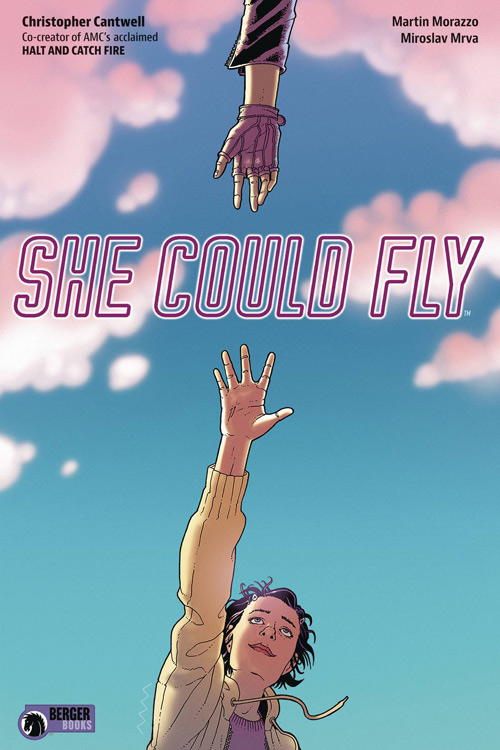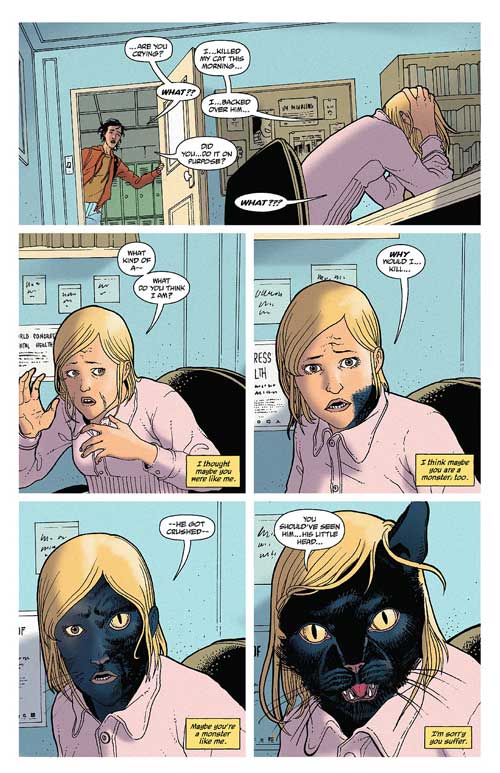The Sky Was The Limit If She Could Fly
Nov 05, 2018
 |
by Vince Brusio
To write a story that is personal can be just as daunting as creating future technology for generations unborn. You have to keep in mind that what you think must translate clearly on the page in words or images so that the reader can get the full impact of your meaning. Otherwise, you’ve just written a technical manual for teleportation that’s been used as a classroom handout for 8 year-olds. Writer Christopher Cantwell explains in detail the topography of his thoughts as he seeks to relay the intricacies of the mental disorder “Primarily Obsessional OCD” in the pages of his new book, She Could Fly TP (NOV180262), for Dark Horse Comics. Read our PREVIEWSworld Exclusive interview!
She Could Fly TP (NOV180262) is available to pre-order from the November PREVIEWS catalog.
**********
Vince Brusio: What point of view is used for the story? Who’s the narrator? And is the story told in real time?
Christopher Cantwell: The POV of this story is primarily told through the eyes of Luna Brewster, who is 15-years-old and living in Elmhurst, a suburb of Chicago. The other primary POV in this story is that of Bill Meigs, a disgraced and eccentric physicist who has been living in hiding since trying to make an arms deal with foreign intelligence. The story happens in real time, and all told I believe the four issues take place over only a few weeks.
Vince Brusio: Introduce us to Luna. She’s said to be a “disturbed 15-year-old girl,” but that’s painting with a very broad brush. Who is she? Does she live with mental illnesses? Was that challenging for you to write?
Christopher Cantwell: Luna is an only child of a working-class family. She is severely suffering from an undiagnosed mental disorder, often referred to as ‘Pure O’ or ‘Primarily Obsessional OCD.’ This means that her mental obsessions and ruminations are powerful, and dominate much of her thinking. She's plagued by disturbing thoughts she can’t get rid of, and it’s really informed her inward, awkward personality. It was challenging for me to depict this because I too suffer from the same type of OCD. I lived with it in complete secret for most of my life, and my childhood and adolescence were the hardest. I wanted to give an accurate and authentic depiction of this kind of experience in the pages of She Could Fly. The comic book medium allows for a vivid illustration of the horrific things someone with this type of OCD can experience, and once I saw Martin and Miroslav’s completed images of what I’d written, it reminded me of some of the more disturbing episodes I’d gone through in life. But it was ultimately cathartic, and therapeutic. I hope it’s the same for readers privately experiencing something similar, so they can see they’re not alone.
Vince Brusio: Give us some background on the other characters in the story. Who is passing through Luna’s life with her? How do they help or hurt her?
Christopher Cantwell: Luna has two very sweet parents, Benji and Delores. However, they’re completely unequipped to deal with the intricacies of their daughter’s illness, and at the start of the story, don’t know about it at all. It’s mostly hidden from them, so they are comfortable believing everything’s fine. They are well-meaning but come from that Boomer / Gen X TV generation, where they don’t focus too much on underlying issues. Their worlds are thrown into disarray, however, as Luna’s obsessions finally start to create real problems for the family. That, plus the sudden arrival of Benji’s mother from a seven-year disappearance in Japan, really turns the Brewster family on its head. Kido has been practicing Zen overseas for nearly a decade and now has returned home. We’ll quickly learn that she may not be doing well mentally, either. Her unique state will have a profound effect on Luna and Benji throughout the series. My own grandmother came to live with us while ill when I was in eighth grade, and the experience was life-defining. She was the same, but also different, and it was hard for all of us to deal with that under the same roof.
On the other side of this story, we have Bill Meigs, who spent years working on a special device and was never able to figure it out. He then decided to sell his research to spies and get out of the business, but it proved to be only the latest in a series of bad decisions in his life. He’s wracked by feelings of guilt and failure, and now paranoia, since he’s had to go into hiding. It seems he’s also never been entirely stable to begin with. The only person he’s close to is a prostitute he’s met in hiding in Canada, Verna. Verna is sharper than she lets on, and is a great grounded counterbalance to Bill’s scatterbrained crap. She genuinely cares about him, and he cares for her.
I’d say the other major character worth talking about here is Dana Church, Luna’s high school guidance counselor. She’s new at the school and has a backstory that will be explored in the series. She becomes attached to Luna, primarily because Luna is so guarded and hard to reach. Dana becomes very invested in Luna’s safety in this story, for reasons that will be explored. She also seems to be privately suffering herself, trying to get her life together.
All the characters are lenses through which we explore this idea that, despite the faces we put forward, we’re all constantly struggling with our own emotions and minds.
Vince Brusio: The interior page in the May PREVIEWS appears to show how Luna’s counselor transforms into a cat in Luna’s mind. How does this panel give us a glimpse into the depth and nature of She Could Fly?
Christopher Cantwell: As I mentioned earlier, the comic medium allows us to vividly explore inner thoughts and images. Pure O operates like a brain touching a hot stove, but never learning its lesson. In a way, it becomes addicted to the fear and dread sensation these conjured images can stir up. By fully illustrating them, I think we’ll be able to really probe both the inner workings of someone’s mind and the way they see the world. Not only can it be horrific — and plenty of things that happen in the reality of our story are horrific and violent — but it can also be beautiful. Luna so desires to live in life’s beautiful aspects, best represented by the abilities of the Flying Woman. The love and connection and wonder she experiences (and we experience) are constantly at war with the darker aspects and individuals in life. In that way, the story and characters of She Could Fly are an allegory for that larger struggle we all endure on a daily basis, and I hope that comes through for our readers.
 |
**********
Vince Brusio writes about comics, and writes comics. He is the long-serving Editor of PREVIEWSworld.com, the creator of PUSSYCATS, and encourages everyone to keep the faith...and keep reading comics.




